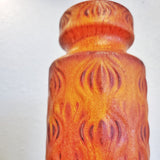





SCHEURICH ‘AMSTERDAM’ VASE Nr. 285/25
CONTACT US HERE ABOUT THIS ITEM.
Designed in 1972 by Oswald Kleudgen, the 'Amsterdam' relief decor, so named for its resemblance to stacks of tulip bulbs, is also commonly known as the 'Onion' decor, and is one of the most popular ever produced by Scheurich Keramik. It was available in a number of sizes and colorways, as well as color combinations, including this orangy-red and brown version that highlights the pattern perfectly.
OSWALD KLEUDGEN was a classmate and close friend of Heinz Siery, the prolific form designer who would ultimately exert huge influence over the style of West German ceramics through his work at several of the best companies of that time. Kleudgen was a top-notch painter and decorator who had collaborated with Siery at Fohr Keramik, and then later at Scheurich when they both went to work there in 1955. Kleudgen would stay at Scheurich even when Heinz left in 1959 to go to work for Carstens. He became the single most important designer of glazes and decors at Scheurich and worked for them until his retirement.
SCHEURICH had its origins in a joint venture launched in 1928 by Alois Scheurich and his cousin Fridolin Greulich in the small town of Schneeberg near the Czech border in Saxony—wholesaling glass, porcelain, and ceramics. The business was moved to the market community of Kleinheubach in the northeast corner of Bavaria in 1938, and ten years later the partners began producing household ceramics of their own, selling them under the name Scheurich & Greulich. In 1954 Alois founded SCHEURICH to continue the production on his own.
The celebrated designer Heinz Siery was recruited the following year. He developed production techniques for SCHEURICH as well as designs. The overarching manufacturing strategy was to produce a wide array of simple forms that could be decorated in a great variety of glazes. This resulted in a range of pieces that was both extensive and economically adaptable. The approach proved altogether successful; through the 1980s SCHEURICH produced more pottery than any other German manufacturer. Much of it was for export.
The earliest SCHEURICH pieces sport discrete colors and simple geometric patterns. In the late 1960s and the '70s, its glazes were characterized by brown-and-green color schemes, sometimes accented with more vibrant hues—however, some décors featured the bold lava and volcanic finishes that are so admired today. Molded décors inspired by ancient cultures or patterns from nature were also represented. By the late 1980s, shapes and color scales became plainer and the work less attractive.
| Designer | OSWALD KLEUDGEN |
|---|---|
| Manufacturer | Scheurich |
| Design Period | 1970 to 1979 |
| Production Period | 1970 to 1979 |
| Country of Manufacture | Germany |
| Identifying Marks | This piece has been attributed based on archival documentation, such as vintage catalogs, designer records, or other literature sources |
| Style | Vintage, Mid-Century, Scandinavian Modern, Modernist, Minimalist |
| Detailed Condition | Excellent — This vintage piece is in near original condition. It may show minimal traces of use and/or have slight restorations. |
| Product Code | |
| Materials | Ceramic |
| Color | Orange, Brown |
| Width | 4.0 inch |
| Depth | 4.0 inch |
| Height | 9.0 inch |






